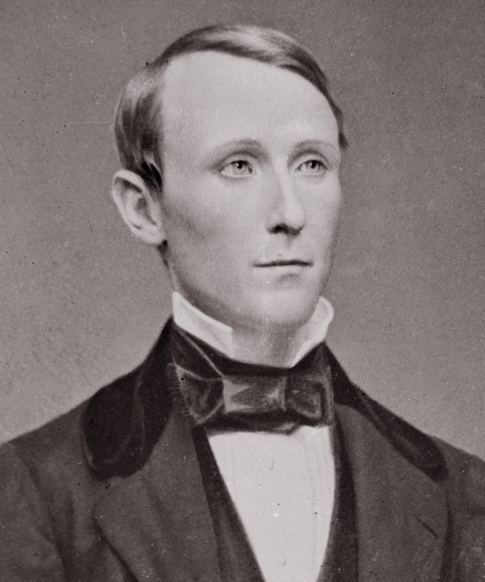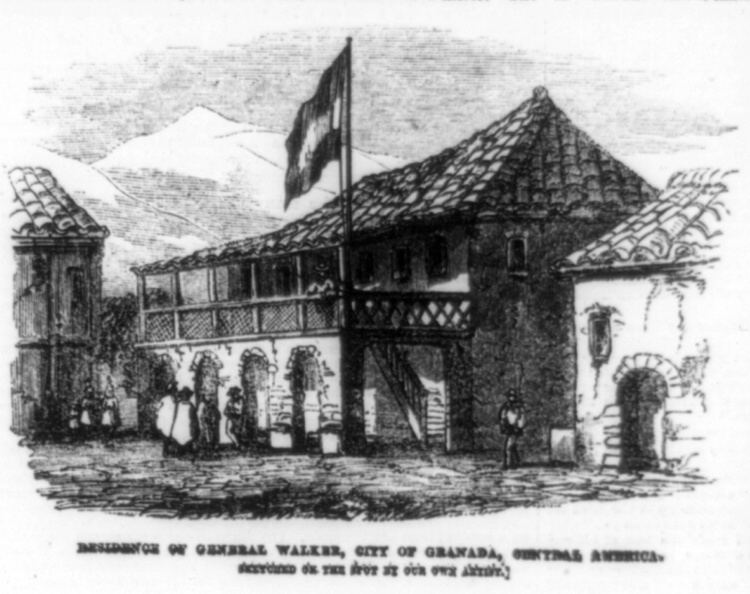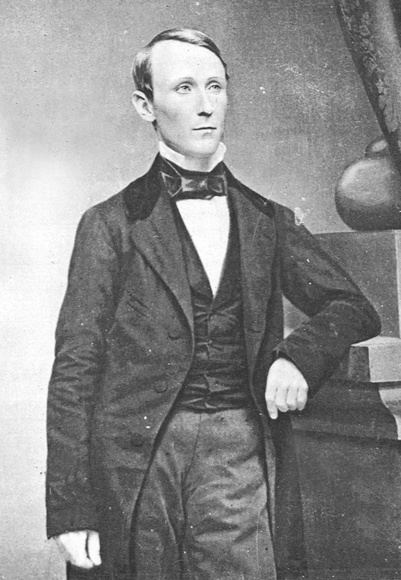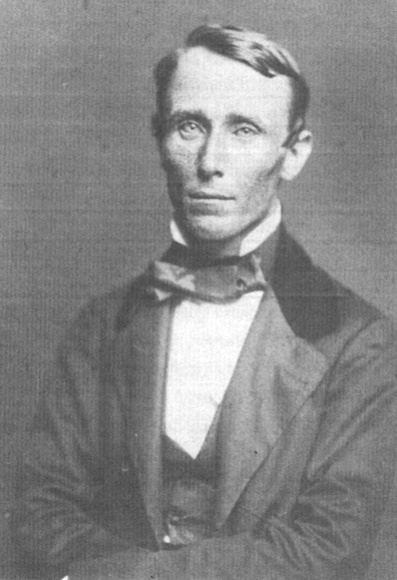Signature | Name William Walker Books The war in Nicaragua | |
 | ||
Succeeded by Maximo Jerez and Tomas Martinez Presidential term July 12, 1856 – May 1, 1857 Similar People Juan Rafael Mora Porr, Cornelius Vanderbilt, Jose Maria Canas, Franklin Pierce, Francisco Castellon | ||
History blast william walker
William Walker (May 8, 1824 – September 12, 1860) was an American physician, lawyer, journalist and mercenary who organized several private military expeditions into Latin America, with the intention of establishing English-speaking colonies under his personal control, an enterprise then known as "filibustering." Walker usurped the presidency of the Republic of Nicaragua in 1856 and ruled until 1857, when he was defeated by a coalition of Central American armies. He was executed by the government of Honduras in 1860.
Contents
- History blast william walker
- quien fue william walker
- Early life
- Duel with William Hicks Graham
- Expedition to Mexico
- Conquest of Nicaragua
- Death in Honduras
- Influence and reputation
- Works
- References

quien fue william walker
Early life

Walker was born in Nashville, Tennessee, in 1824 to James Walker and his wife Mary Norvell. His father was a son of a Scottish immigrant. His mother was a daughter of Lipscomb Norvell, an American Revolutionary War officer from Virginia. One of Walker's maternal uncles was John Norvell, a US Senator from Michigan and founder of The Philadelphia Inquirer. William Walker was engaged to Helen Martin, but they never married, and he died without any children.

William Walker graduated summa cum laude from the University of Nashville at the age of fourteen. He studied medicine at the University of Edinburgh and University of Heidelberg before receiving his medical degree from the University of Pennsylvania at the age of 19. He practiced briefly in Philadelphia before moving to New Orleans to study law.

He practiced law for a short time, and then quit to become co-owner and editor of the New Orleans Crescent. In 1849, he moved to San Francisco, where he was a journalist and fought three duels; he was wounded in two of them. Walker then conceived the idea of conquering vast regions of Latin America and creating new slave states to join those already part of the United States. These campaigns were known as filibustering or freebooting.
Duel with William Hicks Graham
William Walker first gained national attention after his duel with William Hicks Graham on January 12, 1851 in San Francisco. At that time, Walker was the editor of the San Francisco Herald while Graham was a clerk in the employ of Judge R. N. Morrison. The conflict started after Walker criticized Graham and his colleagues in the newspapers, which angered and prompted Graham to challenge Walker to a duel. Graham was a notorious gunman and duellist in his time, having taken part in a number of duels and shootouts in the Old West. Walker on the other hand, had experience duelling with single-shot pistols at one time, but his duel with Graham was to be fought with revolvers.
The combatants met at Mission Dolores and each were given Colt Dragoons with 5 shots. They stood face-to-face at ten paces, and with the signal of a referee, quickly aimed and tried to fire their revolvers. Graham managed to fire two bullets, hitting Walker in his pantaloons and his thigh, seriously wounding him. Walker, though he tried a number of times to shoot his weapon during the duel, failed to fire even a single shot and Graham was left unscathed. The duel ended after the wounded Walker finally conceded, and afterwards Graham was arrested but was quickly released. The duel was recorded in The Daily Alta California.
Expedition to Mexico
In the summer of 1853, Walker traveled to Guaymas, seeking a grant from the government of Mexico to create a colony, using the pretext that it would serve as a fortified frontier, protecting US soil from Indian raids. Mexico refused, and Walker returned to San Francisco determined to obtain his colony, regardless of Mexico's position. He began recruiting from amongst American supporters of slavery and the Manifest Destiny Doctrine, mostly inhabitants of Kentucky and Tennessee. His intentions then changed from forming a buffer colony to establishing an independent Republic of Sonora, which might eventually take its place as a part of the American Union (as had been the case previously with the Republic of Texas). He funded his project by "selling scrips which were redeemable in lands of Sonora."
On October 15, 1853, Walker set out with 45 men to conquer the Mexican territories of Baja California Territory and Sonora State. He succeeded in capturing La Paz, the capital of sparsely populated Baja California, which he declared the capital of a new Republic of Lower California, with himself as president and his partner, Watkins, as vice president; he then put the region under the laws of the American state of Louisiana, which made slavery legal. Fearful of attacks by Mexico, Walker moved his headquarters twice over the next three months, first to Cabo San Lucas, and then further north to Ensenada to maintain a more secure position of operations, because he lost to General Manuel Márquez de León. Although he never gained control of Sonora, less than three months later, he pronounced Baja California part of the larger Republic of Sonora. Lack of supplies and strong resistance by the Mexican government quickly forced Walker to retreat.
Back in California, he was put on trial for conducting an illegal war, in violation of the Neutrality Act of 1794. Nevertheless, in the era of Manifest Destiny, his filibustering project was popular in the southern and western United States and the jury took eight minutes to acquit him.
Conquest of Nicaragua
Since there was no inter-oceanic route joining the Atlantic and Pacific Oceans at the time, and the transcontinental railway did not yet exist, a major trade route between New York City and San Francisco ran through southern Nicaragua. Ships from New York entered the San Juan River from the Atlantic and sailed across Lake Nicaragua. People and goods were then transported by stagecoach over a narrow strip of land near the city of Rivas, before reaching the Pacific and being shipped to San Francisco. The commercial exploitation of this route had been granted by Nicaragua to the Accessory Transit Company, controlled by shipping magnate Cornelius Vanderbilt (see also Nicaragua Canal).
In 1854, a civil war erupted in Nicaragua between the Legitimist Party (also called the Conservative Party), based in the city of Granada, and the Democratic Party (also called the Liberal Party), based in León. The Democratic Party sought military support from Walker who, to circumvent U.S. neutrality laws, obtained a contract from Democratic president Francisco Castellón to bring as many as three hundred colonists to Nicaragua. These mercenaries received the right to bear arms in the service of the Democratic government. Walker sailed from San Francisco on May 3, 1855, with approximately 60 men. Upon landing, the force was reinforced by 110 locals. Within Walker's expeditionary force was the well-known explorer and journalist Charles Wilkins Webber as well as the English adventurer Charles Frederick Henningsen, a veteran of the First Carlist War, the Hungarian Revolution, and the war in Circassia.
With Castellón's consent, Walker attacked the Legitimists in the town of Rivas, near the trans-isthmian route. He was driven off, but not without inflicting heavy casualties. In this First Battle of Rivas a school teacher called Enmanuel Mongalo y Rubio (1834-1872) burned the Filibusters Headquarter. On September 4, during the Battle of La Virgen, Walker defeated the Legitimist army. On October 13, he conquered the Legitimist capital of Granada and took effective control of the country. Initially, as commander of the army, Walker ruled Nicaragua through provisional President Patricio Rivas. U.S. President Franklin Pierce recognized Walker's regime as the legitimate government of Nicaragua on May 20, 1856. Walker's first ambassadorial appointment, Colonel Parker H. French, was refused recognition.
Walker's actions in the region caused concern amongst his neighbors and potential American and European investors who feared he may pursue further military conquests in Central America. Concerned of Walker's intentions in the region, Costa Rican President Juan Rafael Mora rejected Walker's diplomatic overtures and began preparing the country's military for a potential conflict. The most important strategic defeat of Walker came during the Campaign of 1856–57 when the Costa Rican army, led by President Juan Rafael Mora defeated the Filibusters, in Rivas, Nicaragua on April 11, 1856, (the Second battle of Rivas). It was in this battle that the soldier and drummer Juan Santamaría sacrificed himself by setting the filibuster stronghold on fire. In an amazing parallel between these two Central American countries, Santamaría would become Costa Rica's national hero. Walker deliberately contaminated the water wells of Rivas with corpses. Later, the morbus cholera epidemic spread to the Costa Ricans troops and the civilian population of the city of Rivas. A few months later nearly 10,000 civilians died, almost the 10% of the population of Costa Rica.
Meanwhile, C. K. Garrison and Charles Morgan, subordinates of Cornelius Vanderbilt's Accessory Transit Company, provided financial and logistic assistance to the filibusters in exchange for Walker, as ruler of Nicaragua, seizing the Company's property (on the pretext of a charter violation) and turning it over to Garrison and Morgan. Outraged, Vanderbilt dispatched two secret agents to the Costa Rican government with plans to fight Walker. They would help regain control of Vanderbilt's steamboats which had become a logistical lifeline for Walker's army.
Walker organized a battalion of four companies, of which one was composed by Germans, a second by Frenchmen and the other two by Americans totaling 240 men placed under the command of Colonel Schlessinger to invade Costa Rica in a preemptive action, but this advance force was defeated at the Battle of Santa Rosa in March 20, 1856. In April 1856, Costa Rican troops, -conducted by President Juan Rafael Mora, General José Joaquín Mora Porras, and the General José María Cañas (1809-1860) who was a Salvadoran militar who was brother-in-law of President J.R. Mora and a Costa Rican citizen and later also a National heroe-, entered into Nicaraguan territory and inflicted a defeat on Walker's men at the Second Battle of Rivas on April 11, in which Juan Santamaría, later to be recognized as one of Costa Rica's national heroes, played a key role by burning Filibuster´s Headquarters (he dies in this heroic action).
From the north, President José Santos Guardiola also sent Honduran troops who went side by side with Salvadoran troops to fight William Walker under the leadership of the Xatruch brothers. First, Florencio Xatruch was leading his troops against Walker and the filibusters in la Puebla, Rivas. But later, and because of the opposition of other Central American armies, General José Joaquín Mora Porras, brother of Juan Rafael Mora Porras (President of Costa Rica), was made Commandant General-in-Chief of the Allied Armies of Central America in the Third Battle of Rivas (April, 1857).
The leader of all this heroic Campaign, was the Costa Rican President, Juan Rafael Mora, who later was deposed as the Constitutional President in a coup d´état by the Oligarchy, and later brutally shot in Puntarenas, Costa Rica, on 1860 with his supporters General Cañas and his own brother General José Joaquín Mora Porras.
Since those days, Central America was in Civil War, so Honduras and El Salvador recognized Xatruch as Brigade and Division General. On June 12, 1857, Xatruch certainly made a triumphant entrance to Comayagua, which was then the capital of Honduras, after Walker surrendered. The nickname by which Hondurans are known popularly still today, Catracho, and the more infamous nickname Salvadorans are known today, Salvatrucho are derived from Xatruch's figure and successful campaign as leader of the Allied Armies of Central America, as the troops of El Salvador and Honduras were national heroes, fighting side by side as Central American brothers against William Walker's troops.
As the general and his soldiers returned from battle, some Nicaraguans affectionately yelled out "¡Vienen los xatruches!;" meaning, Here come Xatruch's boys! Nevertheless, Nicaraguans had so much trouble pronouncing the general's last name (a North-Eastern Spanish last name, like Guardiola) that they altered the phrase to "los catruches" and ultimately settled on "los catrachos."
Of course, a key historical role was played by the Costa Rican Army in unifying the other Central American armies to fight against Filibusters. The "Campaign of the Transit" (1857), was the name given by Costa Rican historians to the groups of several battles fought by the Costa Rican army, supervised by Colonel Salvador Mora, and lead heroically "in situ" by Colonel Blanco and Colonel Salazar at the San Juan River. By establishing control of this binational river at its border with Nicaragua, Costa Rica prevented any military reinforcements from reaching Walker and his Filibuster troops via the Caribbean Sea. Also Costa Rican diplomacy neutralized US official support for Walker by taking advantage of the dispute between the magnate Cornelius Vanderbilt and William Walker. See also:
Walker took up residence in Granada and set himself up as President of Nicaragua, after conducting a fraudulent election. He was inaugurated on July 12, 1856, and soon launched an Americanization program, reinstating slavery, declaring English an official language and reorganizing currency and fiscal policy to encourage immigration from the United States. Realizing that his position was becoming precarious, he sought support from the Southerners in the U.S. by recasting his campaign as a fight to spread the institution of black slavery, which many American Southern businessmen saw as the basis of their agrarian economy. With this in mind, Walker revoked Nicaragua's emancipation edict of 1821. This move did increase Walker's popularity in the South and attracted the attention of Pierre Soulé, an influential New Orleans politician, who campaigned to raise support for Walker's war. Nevertheless, Walker's army was weakened by massive defections and an epidemic of cholera (probably created by Walker himself when he ordered that the water wells in Rivas and perhaps Granada be contaminated with dead bodies), finally was defeated by the Central American coalition led by Costa Rican President Juan Rafael Mora Porras (1814-1860).
On October 12, 1856, Guatemalan Colonel José Víctor Zavala performed an act of courage: he crossed the square of the city to the house where Walker soldiers took shelter; under heavy fire, he made it to the enemy's flag and carried it back with him shouting to his men that the Filibuster bullets did not kill.
On December 14, 1856, as Granada was surrounded by 4,000 Costa Rican, Honduran, Salvadoran and Guatemalan troops, Charles Frederick Henningsen, one of Walker's generals, ordered his men to set the city ablaze before escaping and fighting their way to Lake Nicaragua. When retreating from Granada, the oldest Spanish colonial city in Nicaragua, he left a detachment with orders to level it in order to instill, as he put it, “a salutary dread of American justice.” It took them over two weeks to smash, burn and flatten the city, but flatten it they did; all that remained were inscriptions on the ruins that read “Aqui Fue Granada” (“Here Was Granada”).
On May 1, 1857, Walker surrendered to Commander Charles Henry Davis of the United States Navy under the pressure of Costa Rica and the Central American armies, and was repatriated. Upon disembarking in New York City, he was greeted as a hero, but he alienated public opinion when he blamed his defeat on the U.S. Navy. Within six months, he set off on another expedition, but he was arrested by the U.S. Navy Home Squadron under the command of Commodore Hiram Paulding and once again returned to the U.S. amid considerable public controversy over the legality of the Navy's actions.
Death in Honduras
After writing an account of his Central American campaign (published in 1860 as War in Nicaragua), Walker once again returned to the region. British colonists in Roatán, in the Bay Islands, fearing that the government of Honduras would move to assert its control over them, approached Walker with an offer to help him in establishing a separate, English-speaking government over the islands. Walker disembarked in the port city of Trujillo, but soon fell into the custody of Commander Nowell Salmon (later Admiral Sir Nowell Salmon) of the British Royal Navy. The British government controlled the neighboring regions of British Honduras (now Belize) and the Mosquito Coast (now part of Nicaragua) and had considerable strategic and economic interest in the construction of an inter-oceanic canal through Central America. It therefore regarded Walker as a menace to its own affairs in the region.
Rather than return him to the US, for reasons that remain unclear, Salmon sailed to Trujillo and delivered Walker to the Honduran authorities, together with his chief of staff, Colonel A. F. Rudler. Rudler was sentenced to 4 years in the mines, but Walker was sentenced to death, and executed by firing squad, near the site of the present-day hospital, on September 12, 1860. Walker was 36 years old. He is buried in the Old Cemetery, in Trujillo.
Influence and reputation
William Walker convinced many Southerners of the desirability of creating a slave-holding empire in tropical Latin America. In 1861, when U.S. Senator John J. Crittenden proposed that the 36°30' parallel north be declared as a line of demarcation between free and slave territories, some Republicans denounced such an arrangement, saying that it "would amount to a perpetual covenant of war against every people, tribe, and State owning a foot of land between here and Tierra del Fuego."
Before the end of the American Civil War, Walker's memory enjoyed great popularity in the southern and western United States, where he was known as "General Walker" and as the "grey-eyed man of destiny." Northerners, on the other hand, generally regarded him as a pirate. Despite his intelligence and personal charm, Walker consistently proved to be a limited military and political leader. Unlike men of similar ambition, such as Cecil Rhodes, Walker's grandiose scheming ultimately failed against the union of Central American people.
In Central American countries, the successful military campaign of 1856–57 against William Walker became a source of national pride and identity, and it was later promoted by local historians and politicians as substitute for the war of independence that Central America had not experienced. April 11 is a Costa Rican national holiday in memory of Walker's defeat at Rivas. Juan Santamaría, who played a key role in that battle, is honored as one of the two Costa Rican national heroes, the other one being Juan Rafael Mora himself.
